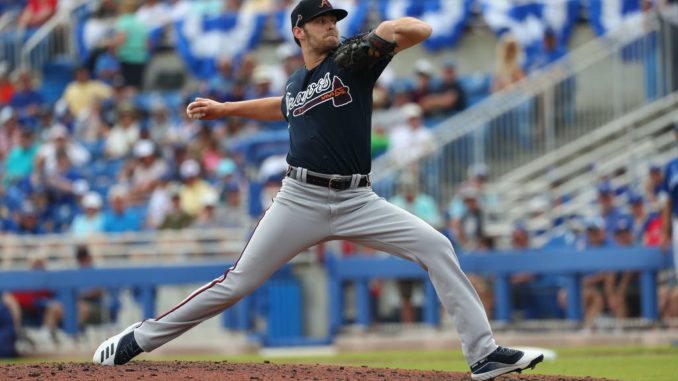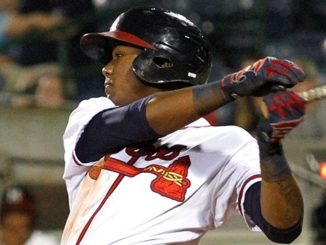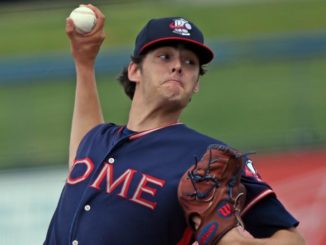
Injuries and poor performances by Braves starting pitchers continue to give opportunities to young players.
The Braves have announced that their top pitching prospect has been selected to join the team and will make his debut start tonight.
The Player
Ian Anderson, RHP
Age: 22
OFR Prospect Rank: 2
2019 Level: AAA Gwinnett
The Results (2019)
3.38 ERA/3.55 FIP (AA/AAA)
26 G, 26 GS
135.2 IP
4.31 BB/9
11.41 K/9
The History
The third overall pick in the 2016 draft, Anderson was a star out of Shenendehowa High School in Clifton Park, NY. Anderson overcame pneumonia in his senior year of high school and the Braves were very cautious with his innings in his first pro season, limiting him to 40 in rookie ball, where he had a sterling 2.04 ERA/2.93 FIP. That cautiousness continued in 2017 at Rome, as Anderson was limited to 80 innings overall and only 17.2 innings after July 1. Nevertheless, Anderson showed flashes of dominance and held opponents to a .232/.348/.268 batting line against. Anderson only allowed 10 extra base hits against him and no home runs in his class-A season.
Anderson started and spent most of the 2018 season at High-A Florida, starting slowly due to early pitch counts and adjusting to the level of competition. However, in his remaining 16 Florida starts, Anderson allowed just a 1.78 ERA while striking out 100 and walking 30 in 86 innings . On August 14 of that year, Anderson was promoted to AA Mississippi where he made his final four starts of the season. Anderson finished off his last two starts by throwing a total of 12.2 shutout innings, allowing just five hits and three walks while striking out 19.
Ian Anderson began 2019 at the head of the Mississippi rotation. Like 2018, he got off to a bit of a slow start in his first four outings, giving up thirteen walks and nine earned runs in his first seventeen innings before tossing a couple of scoreless six-inning starts. After two more rough outings, Anderson went on a tear beginning May 19th through his last Mississippi start at the end of July, during which he posted a 2.03 ERA and 11.5 K/9 rate while walking just 2.7 per nine. He also gave up more than two earned runs in a start just once during this period. His best start during this run was in a combined no-hitter on June 28th at home vs. Jackson where he struck out 14 and walked just 2 in 7 innings before giving way to Jeremy Walker to finish it off. This stretch got him promoted to Gwinnett in early August, where he found trouble adjusting both to the level of competition as well as the AAA/MLB baseball. In five starts, Anderson put together a 6.57 ERA with eighteen walks and an uncharacteristic five home runs allowed in just 25 innings.
Anderson was named the 2019 Minor League Pitcher of the Year by the Braves organization and was the Braves 2019 Minor League Player of the Year for Baseball America. Baseball America currently ranks Anderson as the 45th-best prospect in baseball.
The Report
Anderson is listed at 6’3″ and 170 pounds, which may have been accurate when he signed his first contract back in 2016, but he’s likely added at least 20 pounds and one or two inches in height since that time. Anderson has a true overhand delivery, a bit of a throwback among Braves pitching prospects, almost all of whom rolls with a three-quarter’s delivery. The over-the-top motion allows him to get strong vertical movement on all his pitches. His four-seam fastball has touched ~97 mph, but usually sits in the 92-94 mph range. He typically tries to stay under bats with it, but he has shown the ability to elevate as well. This is a typical Anderson 4-seamer, 93 mph on the outside corner taken for strike one by Clint Frazier.
https://giphy.com/gifs/J5kEB3l4ohSTp8x4Cm
Anderson’s primary secondary pitch is a 12-6 curveball that he can vary the break and speed with, but usually thrown with a sharp break in a manner that 17th-century poet and baseball enthusiast Thomas Hobbes may describe as nasty, brutish, and short. Anderson finishes of Frazier in that same at-bat with the curve here.
https://giphy.com/gifs/fwzXkF5V493yh8wTpZ
Anderson also employs an excellent straight change-up that he uses primarily against left-handed batters, a primary reason why through his minor league career he has held lefties to a .193/.293/.278 batting line against him, striking out 30% of the lefty batters faced. Anderson does an excellent job disguising this pitch, making it much harder for the hitter to track, and it runs about 10 mph slower than the fastball. Here Anderson starts out Gosuke Katoh with a first-pitch change-up at 84 mph.
https://giphy.com/gifs/IguMgMOkjDQCkqZEjo
The knocks on Anderson is that because he gets lackluster spin rates on all of his pitches he has little horizontal movement, so he needs to locate well. Anderson can be prone to nibbling around the strike-zone, which can cause rashes of walks. Anderson has done a good job suppressing home runs in the minor leagues, except for during the 5-game stint with AAA Gwinnett at the end of 2019; at the time AAA baseball was using the same “rabbit” ball that the major leagues were using that helped the International League set offensive records.
What’s Next
Anderson will get his first major league start against the American League leader in runs per game, but missing three top contributors in Gleyber Torres, DJ LeMahieu, and Giancarlo Stanton. With the rotation in essentially a constant state of flux since before the season actually began, look for Anderson to be given a long look at holding down one of the spots, even if he has a rough outing or two.




Leave a Reply